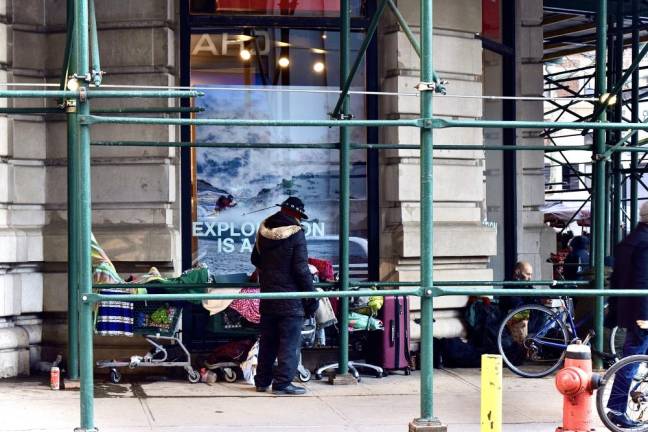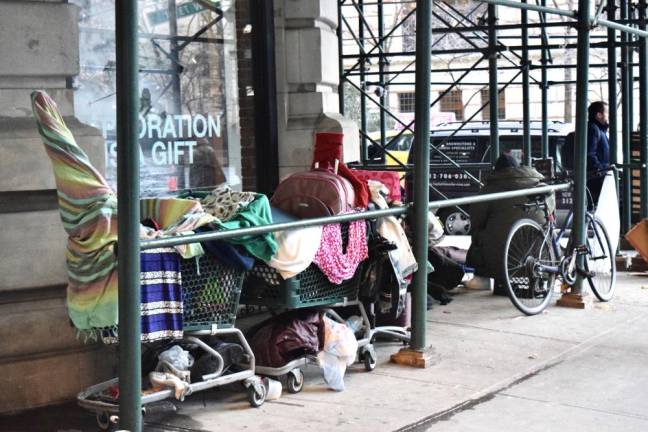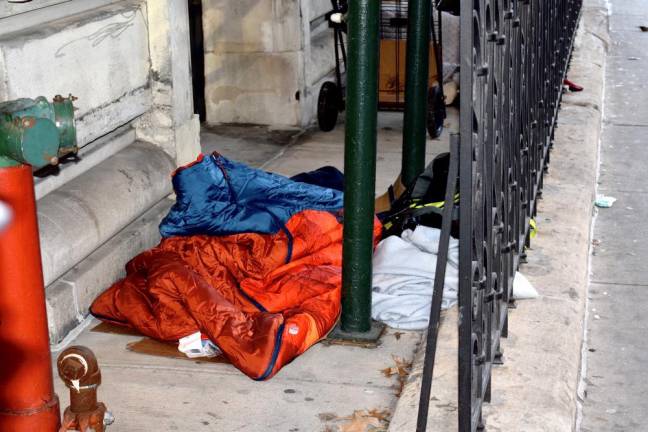Seeking Safer Streets
Amid a growing sense of unease, UWS residents, elected officials and experts hunt for solutions to homelessness
Over the last year, Elizabeth Carr has witnessed a shift in her neighborhood on the Upper West Side. She and others have noticed encampments of homeless people sleeping on mattresses in front of empty storefronts, something they had not seen before. She said she has frequently been accosted verbally by a man on the street, who she said obviously suffers from mental illness, while walking with her children.
“As a someone who's lived in the neighborhood for 15 years, and as a mother of three children, I was starting to feel unsafe in the neighborhood for the first time,” Carr said in an interview. “Frankly, around the city, I was observing anecdotally, a very different sense, and what it felt like to walk down the street.”
At the same time, residents in the neighborhood have been shaken by a sense that violent crime was also on the rise, particularly in the wake of last week’s stabbing death of first year Barnard College student, Tessa Majors, in Morningside Park.
But the initial event that became the catalyst for Carr to act was a shooting incident on 64th Street and West End Avenue near a playground. So she started a Facebook group originally called Upper West Side Quality of Life and now called NYC Moms for Safer Streets. The group is nearly 1,700 strong, with a core group of ten who have begun lobbying elected officials to take action.
Carr says it has been a tricky line to walk so as not to conflate the issue of crime with the issue of street homelessness in the neighborhood.
“We're very clear that there is no link between aggressive mentally ill homeless on the street and what's going on on the crime front, but for the fact that they both contribute to a sense of unease that seems to be felt by people definitely throughout the Upper West Side,” Carr said.
She said she wants to be sure that her group is compassionate when it comes to the issue of street homelessness, but that having compassion doesn’t mean authorities who are supposed to be dealing with the problem shouldn’t be held to account.
“Our hearts absolutely go out to people whose lives have come to this,” Carr said. “We reject the idea that there's anything compassionate or humane about allowing people really to kind of self destruct on our streets.”
Her group has been asking elected officials and police what they are doing to help solve the issue, and whether there are big, new pilot programs or policy solutions that can be implemented.
The Mayor's Action Plan
Last week, Mayor Bill de Blasio released a comprehensive, six-point action plan to end street homelessness over a five-year stretch. The plan aims to increase access to housing, mental health and medical services for homeless individuals, as well as improve the city’s outreach efforts to those living on the streets.
“Homeless New Yorkers are just like us — they deserve our love and compassion and a commitment to go as far as we can to help,” de Blasio said in a statement. “So here’s our promise: we will help every last person experiencing long-term homelessness off our streets and we will do more than we ever thought possible to bring them home.”
Through the plan, the city aims to add 1,000 beds to ‘safe haven’ shelters, which have fewer rules of entry than other shelters. In collaboration with housing and social services providers, the city will work to identify privately-owned properties that can be converted into housing to provide 1,000 permanent housing units for currently unsheltered people.
The city will also be expanding its Street Medicine to all five boroughs, delivering rapid response medical care directly to where people are on the streets and in the subways. This includes stepping up mental health services where they are, which the city hopes will help build trust between agencies and the homeless population.
“There are many layers to the homelessness crisis, and everyone knows there is no quick fix. But, we have to start somewhere, and first and foremost we should be working to get as many folks as possible off the streets and into shelters,” Manhattan Borough President Gale Brewer told Straus News.
Political Will and Community Support
Carol Caton, a professor of sociomedical sciences at Columbia who has long researched homelessness, said the safe haven shelters to which de Blasio’s plan aims to increase access has been an effective way to get people off the street.
“Safe havens are a way of getting people off the street without having them have to go through (detoxifying) or agreeing to be in any kind of treatment,” Caton said. “They can just go into the safe haven and stay there. If they're interested in getting services they can explore mental health or substance abuse treatment services.”
But still, Caton said people might want to stay on the street if they’ve had a poor experience in a previous shelter or they want to stay on the street to panhandle so that they might be able to make a few dollars to buy food.
The key to long-term success, though, Caton said, involves big investment in affordable housing. It takes a great deal of political will, a lot of money and enthusiastic community support, Caton said, but it can be done.
Carr said she applauds the plan de Blasio has put forward, but she’s reserving judgment until the resources are in place to put the plan into action.
“It's one thing to announce a big vision that we all hope succeeds,” said Carr. “But, since the administration has only has 35 percent of the goal number of beds in the works, and, apparently, (none) of the goal number of apartments secured, this announcement strikes me as premature.”
As an election year approaches, Carr said she hopes her group can wield some influence and the ear of candidates to keep their message in the public sphere.
“We are hoping to identify and support candidates for city council and mayor who are taking the issue seriously, and who are also bringing fresh energy towards these ideas,” Carr said.
“There is no quick fix [to the homelessness crisis]. But we should be working to get as many folks as possible off the streets and into shelters.” Manhattan Borough President Gale Brewer


